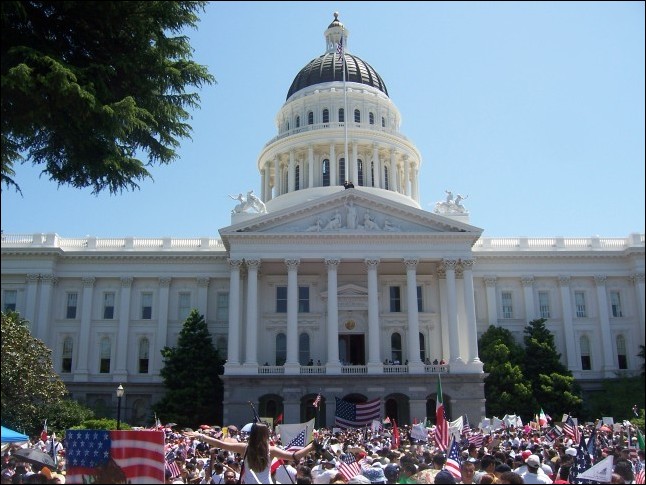ASI president helps lead charge on Capitol
Image: ASI president helps lead charge on Capitol:About 300 students converged on the state Capitol on Monday to protest a proposed immigration bill.Photo courtesy of Julio Garcia:
May 3, 2006
While most students were rolling out of bed at 8 a.m. on Monday, Angel Barajas, Associated Students Inc. president, was waving an American flag and leading a fleet of 75 to 100 students to the steps of the state Capitol.
The goal of the protesters: to send a message to Washington that the U.S. House of Representatives bill, which would make many illegal immigrants felons, would not be tolerated by the 11 million illegal immigrants nationwide ?” and the 2.5 million illegal immigrants who live in California.
The day, deemed “The Great American Boycott 2006” by a California Senate resolution, sought to draw attention to the contributions of the illegal immigrant population, including contributions of $4.5 billion in state taxes and $30 billion in federal taxes, according to the resolution.
“It was in order to show support for Latino immigrants in the state and country,” said Delfina Pedilla, a senior psychology major.
Pedilla, a child of farm worker immigrants, said she doesn’t believe illegal immigrants are a drain to the U.S. economy and should be given their civil rights.
Wearing white shirts ?” a symbol of peace ?” the student protesters, organized by the Chicano Student Movement of Aztlán (MEChA), marched more than seven miles, joining other Chicano groups at Southside Park in downtown Sacramento and arriving at the Capitol as the sun hung directly over the sky.
Barajas said at one point Sac State students, accompanied by other college and high school participants, totaled more than 300.
A separate stream of protesters, made up mainly of labor groups, met at the federal immigration building on the corner of 5th Street and Capitol Avenue, and marched toward the Capitol, merging with the Southside Park group. “It was beautiful when you stood at the Capitol stairs ?” it was an ocean of white,” said Maria Lopez, a junior criminal justice major. For Lopez, the march signaled her first visit to the Capitol and her first time protesting. She said the sight was breathtaking “seeing all these people united for one cause.”
For several hours drums and bullhorns sang out as 15,000 to 18,000 protesters, according to police, and 30,000 to 40,000 protesters, according to many participants, surrounded the Capitol chanting “Sí se puede” or “Yes, it can be done” and waving Mexican, American and white flags. Protesters also held signs bearing messages such as “I love immigrants” and “Legalize not criminalize.”
Protesters also came out in many major cities nationwide: nearly 1 million in Los Angeles; 12,000 in New York; 55,000 in San Francisco; and 300,000 in Chicago, according to CNN.
Barajas, whose Nu Alpha Kappa fraternity members volunteered as security personnel, making sure protesters knew their rights, grew up accustomed to visits from his undocumented uncle and other illegal immigrants in his family. His father and sister are natives of Mexico.
“They are hard working people, they are big on family and very humble individuals,” Barajas said of the Mexican immigrants.
The protest, which was a mix of ages and ethnicities, represented the mix of illegal immigrants in California, Barajas said.
Eric Guerra, ASI president in 2002-03, also volunteered at the march.
An undocumented immigrant himself, working as a janitor during his earlier years at the university, Guerra got his citizenship during his sophomore year of college.
Guerra said many of his engineering friends who were “smart kids taking physics and three dimensional calculus” could not apply for financial aid without legal status ?” a process that usually takes six to seven years, he said.
Guerra, who has worked closely with the immigration issue as a Fellow and now staffer in Senator Gill Cedillo’s office (D-Los Angeles), said he feels there is lack of understanding surrounding immigration and the hurdles of U.S. citizenship.
Now that many immigrant families are mixed ?” with some members who are illegal and some who have gained citizenship ?” it is difficult to deport people, breaking the familial ties, Guerra said. Guerra said he came out to help citizens and policy makers “recognize that we have a defunct system and we need to change it.”
To those who criticize the protesters as being “un-American,” Guerra said, “That is the most American thing you can do ?” petition your government for grievances.”Nicole Ishiara, a sophomore sociology major, protested with MEChA and came out to march for those who didn’t have the luxury of missing work or class. “A lot of people can’t march today, and it’s important that I march for them.”
Mimi Beas, co-chair of MEChA and ASI chief of staff, helped organize the event after students expressed interest at the group’s meeting.
For Beas, the purpose of the march was “to show solidarity and to take direct action to our community ?” to raise awareness on the issues we are facing.”
Barajas said he was amazed that the day of protest was organized after the immigration bill has been public for only 5 months ?” since November.
Barajas said he could feel the cohesiveness of the protest, which he thinks will impact the economy, sending a message to policy makers.
Jessica Weidling can be reached at [email protected]







































































































































